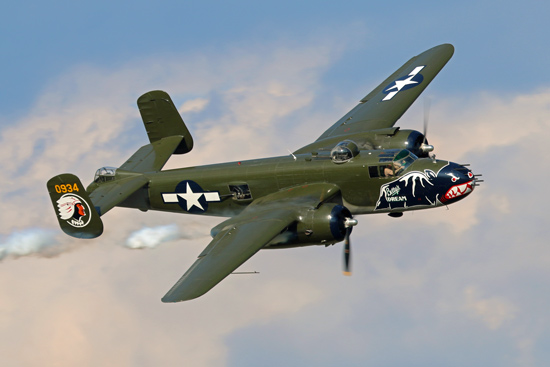North American
B-25 Mitchell
(Variants/Other Names: PBJ-1, Mitchell
I/II/III)

Photo by Buck Wyndham,
Copyright 2015
History: The B-25 was made immortal on April
18, 1942, when it became the first United States aircraft to bomb the Japanese mainland.
Commanded by Lieutenant Colonel James Doolittle, sixteen Mitchells took off from the
aircraft carrier USS Hornet, flew 800 miles (1287 km) to Japan, and attacked
their targets. Most made forced landings in China. They were the heaviest aircraft at the
time to be flown from a ship at sea.
The B-25 was designed for the United States' Army Air Corps before the Second World War.
The North American company had never designed a multi-engine bomber before. The original
design had shoulder-mounted wings and a crew of three in a narrow fuselage. The USAAC then
decided its new bomber would need a much larger payload -- double the original
specifications. North American designers dropped the wing to the aircraft's mid-section,
and widened the fuselage so the pilot and co-pilot could sit side-by-side. They also
improved the cockpit. The USAAC ordered 140 aircraft of the new design right off the
drawing board. There were at least six major variants of the Mitchell, from the initial B-25A
and B-25B, with two power-operated two-gun turrets, to the
autopilot-equipped B-25C, and the B-25G
with 75mm cannon for use on anti-shipping missions. The British designated the B-25Bs as
the Mitchell I, the B-25C and B-25Ds as the Mitchell
II, and their B-25Js, with 12 heavy machineguns,
as the Mitchell III. The US Navy and Marine Corps designated
their hard-nosed B-25Js as the PBJ-1J. In the end, the B-25
became the most widely used American medium bomber of World War Two.
After the war, many B-25s were used as training aircraft. Between 1951 and 1954, 157
Mitchells were converted as flying classrooms for teaching the Hughes E-1 and E-5 fire
control radar. They were also used as staff transport, utility, and navigator-trainer
aircraft. The last B-25, a VIP transport, was retired from the USAF on May 21, 1960.
Approximately 34 B-25 Mitchells remain flying today, most as warbirds, although at least
one earns its keep in Hollywood as an aerial camera platform.
Nicknames: Billy's Bomber (after
General Billy Mitchell); Bank (NATO code name for Russian Lend-Lease B-25s).
Specifications (B-25J):
Engines: Two 1,700-hp Wright R-2600-92 Cyclone radial piston engines
Weight: Empty 19,480 lbs., Max
Takeoff 35,000 lbs.
Wing Span: 67ft. 7in.
Length: 52ft. 11in.
Height: 16ft. 4in.
Performance:
Maximum Speed at
13,000 ft: 272mph
Ceiling: 24,200
ft.
Range: 1,350
miles
Armament:
12 12.7-mm
(0.5-inch) machine guns
4,000 pounds of
bombs
Number Built: 9,889
Number Still Airworthy: ~34
 [
B-25
Pilot Report by Budd Davisson ]
[
B-25
Pilot Report by Budd Davisson ]
 [
B-25
Photos ]
[
B-25
Photos ]
Links:
Aero Trader, Chino, California -- B-25
parts, maintenance and restoration.
American
Aeronautical Foundation -- Operators of B-25J "Executive Sweet."
"Fighting the U-Boats:
The B-25 Mitchell"
Heavenly Body -- Lots of B-25 info and photos.
Light and Medium Bombers of WWII --
Discussion groups, research information, etc.
MaxAir2Air.com B-25 Photo Feature -- Detail photos of "Miss Mitchell."
Michael
McFayden's Scuba Dive Report -- (Underwater B-25 in Madang, Papua New Guinea)
"Miss Mitchell" History Rides -- Fly in a
B-25!
PhotoVault:
B-25 Photos
Rag Wings & Radials -- B-25J
"Panchito."
"Super
Rabbit" -- B-25J based in Salem, Oregon, USA.
The Heavenly Body -- A novel
about B-25 crews in the South Pacific, by Robert E. Shanks.
Warbirds
Unlimited Foundation -- operators of B-25H "Barbie III," based in Mesa,
Arizona, USA.
"Yellow Rose" -- The
website of the Yellow Rose B-25 Squadron of the CAF.
B-25 Mitchell books from Amazon.com:

[ Click for more great books
about the B-25! ]

[Back to Warbird Alley's Main
Page]
All text and photos Copyright 2015 The Doublestar Group, unless otherwise noted.
You may use this page for your own, non-commercial reference purposes only.

Feel free to put this banner on
your website! |